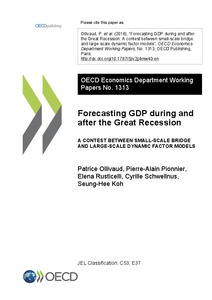Forecasting GDP during and after the Great Recession: a contest between small-scale bridge and large-scale dynamic factor models
"This paper compares the short-term forecasting performance of state-of-the-art large-scale dynamic factor models (DFMs) and the small-scale bridge models routinely used at the OECD. Pseudo-real time out-of-sample forecasts for France, Germany, Italy, Japan, United Kingdom and the United States...
| Main Authors: | , , , , |
|---|---|
| Institution: | ETUI-European Trade Union Institute |
| Format: | TEXT |
| Language: | English |
| Published: |
Paris
2016
OECD |
| Subjects: | |
| Online Access: | https://www.labourline.org/KENTIKA-19101354124919295369-Forecasting-GDP-during-and-aft.htm |
| Summary: | "This paper compares the short-term forecasting performance of state-of-the-art large-scale dynamic factor models (DFMs) and the small-scale bridge models routinely used at the OECD. Pseudo-real time out-of-sample forecasts for France, Germany, Italy, Japan, United Kingdom and the United States during and after the Great Recession (2008-2014) suggest that large-scale DFMs are not systematically more accurate than small-scale bridge models, especially at short forecast horizons. Moreover, DFM parameters appear to be highly unstable during the Great Recession (2008-2009), making forecast revisions between successive vintages difficult to explain as revisions cannot be fully attributed to news on specific groups of indicators. The implication for OECD forecasting practice is that there would be no gain from switching from the current small-scale bridge models to large-scale DFMs." |
|---|---|
| Physical Description: | 36 p. Digital |

